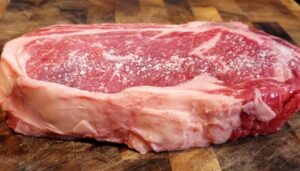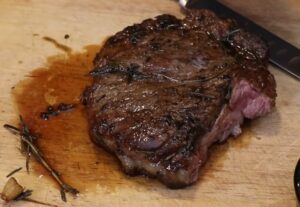A ribeye steak cooked in a screaming hot cast iron skillet has a certain way of making you feel like you know exactly what you are doing, even if you are still figuring out the finer points of kitchen confidence.
A good crust, a glossy pool of garlic butter, fresh herbs crackling in the heat, and that little cloud of beefy steam drifting up, all of it feels almost unfairly achievable. No patio grill, no restaurant broiler, no fuss. Just fire, fat, and a heavy pan.
The method works because ribeye and cast iron complement each other so naturally. One has marbling that melts into richness. The other holds heat like it has something to prove. Put the two together with garlic butter and herbs, and suddenly you have a steakhouse moment happening right on your stovetop.
You do not need chef training to pull this off. You only need discipline, good ingredients, and a willingness to preheat your pan properly. Let us walk through everything with some real tips, and the kind of detail that helps you nail the steak instead of guessing your way through the process.
Choosing the Right Ribeye
A ribeye that performs well in cast iron usually checks a few boxes.
Ideal characteristics
| Feature | What You Want | Why It Matters |
| Thickness | 1¼ to 1½ inches | Enough time to form crust without overcooking |
| Weight | 12 to 20 oz | Keeps internal temperature stable |
| Bone-in | Optional | Dramatic look, but slightly trickier to cook evenly |
| Grade | Choice or Prime | Better marbling, better flavor |
If you are at a butcher shop, ask for steaks cut from the center of the ribeye roll. Center cuts have more even fat distribution.
Dry-Aged or Standard
Dry-aged ribeyes bring a deeper, nuttier flavor. They cook exactly the same as standard ribeyes, so there is no special technique involved.
If you are still learning the process, start with standard choice. Once you are comfortable, upgrade to dry-aged or Prime for a richer experience.

Cast Iron Ribeye Steak with Garlic Butter and Fresh Herbs
Ingredients
Equipment
Method
- Salt With Intention: Season the ribeye steaks generously with kosher salt at least 40 minutes before cooking. This draws out moisture and allows the salt to reabsorb for deep seasoning. If you're short on time, salt just before cooking.

- Preheat the Skillet: Place the cast iron skillet over medium-high heat for 3–5 minutes, until hot. Add the oil and swirl to coat. The oil should shimmer but not smoke aggressively.

- Sear the First Side: Place the steaks in the pan away from you to avoid splatter. Don’t move them—let them sear undisturbed for 2–3 minutes to build a solid crust.

- Add Butter, Garlic, and Herbs: Add butter, smashed garlic cloves, rosemary, and thyme. Let the butter melt and foam. Tilt the pan and baste the steaks with the hot, flavored butter for 1–2 minutes, using a spoon.

- Rest: Transfer steaks to a cutting board and spoon some butter and herbs over the top. Rest for 5–10 minutes before slicing. This keeps juices in the meat, not on your plate.

Video
Notes
Cooking Tips
- Crust is King: Moisture ruins browning—dry steaks thoroughly.
- Avoid burnt garlic: Use smashed cloves, not minced, during cooking. Minced garlic is best in compound butter.
- Ventilation matters: Cast iron searing can get smoky. Turn on the vent or crack a window.
- Compound butter upgrade: Mix butter, garlic, herbs, salt, and pepper. Chill in a log and slice coins for an elegant finish.
Doneness and Target Temperatures
A thermometer removes guesswork. Here is a practical chart.
| Doneness | Pull At | After Rest | Visual Cues |
| Rare | 120 to 125°F | 125 to 130°F | Red center, soft |
| Medium rare | 125 to 130°F | 130 to 135°F | Warm red center |
| Medium | 135 to 140°F | 140 to 145°F | Pink center |
| Medium well | 145 to 150°F | 150 to 155°F | Thin pink band |
| Well done | 155°F+ | 160°F+ | No pink |
Food-safety organizations recommend 145°F with a 3-minute rest. Many home cooks choose medium rare or medium to keep a ribeye tender.
Managing Smoke and Common Problems
Steak in cast iron always creates a bit of drama. You can reduce the chaos by:
- Using neutral oil for the initial sear
- Adding butter later
- Turning the heat down slightly after browning
- Using the vent hood and a window
If you cook multiple steaks back to back, consider finishing them in a low oven to control smoke.
Uneven Browning
Cast iron distributes heat slowly, and burners often create hot spots. A few simple habits help:
- Use a burner close to the diameter of your pan
- Rotate the pan during preheating
- Move the steaks if one area cooks faster
Garlic Turning Bitter
If your garlic is almost black and smells harsh, pull it out. Add new cloves once the butter cools slightly. Whole cloves burn more slowly than minced garlic.
Variations on Garlic Butter and Herbs
@thomas_straker Garlic & herbs @All Things Butter Butter, parsley, garlic, lemon juince, lemon zest, salt & pepper #allthingsbutter #garlicbutter
If you feel like exploring other flavor directions, try variations.
- Thyme, rosemary, and sage for a cold-weather flavor
- Tarragon and parsley for a French angle
- Oregano and marjoram for a Mediterranean profile
You can also splash a bit of red wine or brandy into the pan after removing the steaks. Scrape up the brown bits and reduce it into a quick sauce.
Compound Butter for Serving
A simple compound butter brings a polished restaurant finish.
Base ratio
- 8 tablespoons butter
- 1 to 2 tablespoons chopped herbs
- 1 grated garlic clove
- ½ teaspoon salt
Shape it into a log and slice coins over the finished steak.
Serving and Leftover Ideas
After resting, slice the steak across the grain. Keep the slices thick so they stay juicy. Pour any butter from the pan and the cutting board over the top.
Side dishes that play well with ribeye include:
- Roasted potatoes
- Mashed potatoes
- Sautéed asparagus
- Green beans
- A crisp salad with vinaigrette
Using Leftover Ribeye
Ribeye stays flavorful even cold. You can stretch leftovers in a few smart ways.
- Thinly sliced steak sandwich with arugula and mustard
- Steak salad with vinaigrette
- Breakfast hash with potatoes and eggs
When reheating, use low heat to avoid drying it out.
Putting Everything Together
Cooking a cast iron ribeye with garlic butter and fresh herbs comes down to careful steps repeated with consistency. Choose a steak with good marbling. Salt early, dry thoroughly, and let the chill fade slightly.
Preheat the cast iron skillet and resist the urge to rush it. Sear in high-smoke-point oil, then introduce butter, garlic, and herbs once the crust sets. Baste generously. Monitor the internal temperature. Let the steak rest before slicing.
Once the core technique is second nature, you can experiment with herbs, sauces, and compound butters while still hitting a reliable steakhouse result in your own kitchen. The method rewards patience, precision, and a bit of confidence.
And once you see that crust form, you will know exactly why cast iron ribeye remains one of the great home-cooking moves for anyone who enjoys a rich, perfectly seared steak.
Hi there, my name is Kelly Barlow and kellytoeat.com is my blog. Here, I write about various recipes I want to reccommend to readers.
I try to find the best possible recipes that can attract the attention of readers, and at the same time, I strive to write it in the most engaging manner possible.
When I was younger, I wanted to become a chef. Sadly, it wasn’t meant to be, but at the very least, I write about it.
